How to safely use stairs during an earthquake
table of contents
Introduction
1. Move to the stairs with your belongings
2. Check the stairway doors and handrails
4. Proceed carefully step by step
5.Look ahead and move forward
6. Move to evacuation site
7. Act quietly
summary
Introduction
Earthquakes can occur suddenly and threaten safety inside and outside buildings. When an earthquake occurs, using stairs is an important means of evacuation within a building, but if you do not use them in an appropriate manner, you may be injured. Below, we will explain in detail how to use stairs safely during an earthquake.
1. Move to the stairs with your belongings
1-1 Quick action and calm judgment
When an earthquake occurs, it is important to take immediate action. Make sure you have your belongings with you, and head towards the stairs with a calm mind. It is important to move without panicking and checking your surroundings.
1-2 Prepare and check your belongings
Hold on hand the essential items you will need during the evacuation, such as your cell phone, keys, and wallet. These items are important for communication after evacuation and as necessities for your personal belongings. Don't panic, wear it and be prepared for emergencies.
1-3 Wait in a safe place
Wait in an unobstructed area before moving to the stairs. Choose a location that is away from walls and large furniture and protected from falling objects and obstacles. If you are near a door, consider that the shaking will cause the door to close, and move to a suitable position.
1-4 Check the door and handrail
When you arrive at the stairs, check to see if the stair door is open. If it is closed, carefully open the door and check your surroundings before proceeding. Also, by holding the handrail of the stairs as you move, you can maintain a sense of stability as you move forward.
1-5 Careful step-by-step movement
When descending stairs, take each step carefully. Running down the mountain in a hurry increases the risk of falling, so try to move slowly and steadily. Proceed while paying attention to the steps and swaying beneath your feet.
1-6 Confirm surrounding safety
Always check your surroundings carefully as you move. It is safe to keep an appropriate distance from other evacuees and support each other as you proceed. Be wary of the condition of the stairs and the effects of earthquakes.
1-7 Quiet action and cooperation
Moving quietly allows you to communicate with other evacuees and pass instructions smoothly. Collaborate while communicating with each other and share appropriate evacuation actions.
2. Check the stairway doors and handrails
2-1 Check the condition of the door
Check for shaking : Before opening the door, make sure that the shaking from the earthquake has subsided. If the shaking continues, wait or open the door carefully.
Make sure the door is working : If the door is tightly closed, trying to force it open can cause injury. Check to see if the door is moving at all, so you can open it safely.
2-2 Precautions when opening the door
Check the orientation of the door : Make sure the door is facing you when you open it. If the door is facing you, you must back away safely to open it.
Open without force : Even if the door is moving, open it slowly without using too much force. If you try to open the door too quickly, you may lose your balance.
2-3 Check and use handrails
Handrail stability : Make sure the handrail is firmly fixed. If it appears to be loose or broken, find another handrail or choose another escape route.
Handrail height : Make sure the height of the handrail is suitable for you. You can move while maintaining your balance by firmly grasping the handrail.
2-4 Consideration with multiple people
When checking the stairway doors and handrails, there may be other evacuees nearby. Please be careful of each other and try to evacuate smoothly. It is important to talk to each other and cooperate to avoid confusion.
3. Select the center of the stairs
3-1 Ensuring stability and balance
By choosing the center of the staircase, you will be able to locate it in the most structurally stable location of the building. By staying in the center of the stairs, you can better maintain your balance against shaking and reduce the risk of falling.
3-2 Distance from walls and obstacles
When choosing the center of the staircase, it is also important to maintain the appropriate distance from walls and obstacles. If you are too close to walls or obstacles, objects may fall due to earthquake shaking, so it is safe to evacuate by keeping an appropriate distance.
3-3 Stair width and safety
The center of the stairs is usually the widest part of the stairs, making it easier to maintain distance from other evacuees. Being in the center will help you avoid collisions with other evacuees, although narrow spaces increase the chance of bumping into others.
3-4 Securing a place to escape
By staying in the center of the stairs, you can quickly escape in other directions if necessary. It is possible to move in the appropriate direction depending on the direction of the shaking, expanding the options for evacuation routes.
3-5 Coordination with other evacuees
When you are in the center of the stairs, you can cooperate with other evacuees to advance the evacuation process. Make sure to communicate with others to ensure a smooth evacuation. Being in the center of the stairs will give everyone space to pass safely.
4. Proceed carefully step by step
4-1 Check stride length and step difference
When descending stairs, adjust your stride length appropriately and carefully check the steps as you proceed. The risk of falling increases if you take too long a step or overlook a step, so be careful of your step.
4-2 Proceed while checking your feet
When going down stairs, it is important to always check your step. Particularly in the event of an earthquake, shaking and steps can make your feet unstable, so be sure to put your feet down before stepping on the stairs.
4-3 Use of handrails
If there is a handrail, be sure to grab it when moving. By holding the handrail, you can maintain your balance and make it easier to deal with bumps and swaying. Particularly in the event of an earthquake, handrails provide great support.
4 -4Go one step at a time
Don't rush down the stairs; take one step at a time carefully. Moving quickly can easily cause you to lose your balance, increasing the risk of falls and injuries. Make sure to move slowly and steadily.
4-5 Look ahead and move forward
When going down the stairs, it is important to look ahead. As you move, pay attention not only to your feet, but also to the steps and conditions in front of you. It is safe to check what's ahead, as the stairs may have collapsed or objects may have fallen due to the earthquake.
4 -6 Act quietly
Be quiet and careful when going down the stairs. Screaming or making noise may impede the safety of other evacuees. Move quietly and cooperate with those around you to avoid disruption.
5.Look ahead and move forward
5-1 Check for steps and obstacles ahead
When descending stairs, it is essential to check what kind of steps or obstacles are in front of you to prevent falls. It is important to carefully look ahead as you move forward, as the tremors can make it difficult to see the steps.
5-2 Be careful of changes caused by earthquakes
When an earthquake occurs, the building shakes, which may change the condition of the stairs and the surrounding environment. By looking ahead, you can quickly detect the risk of stairs collapsing or objects falling, and take appropriate action.
5-3 Maintain forward stability
By looking ahead, you can adjust your footing to match the steps and terrain in front of you. This allows you to move forward while maintaining stability on your feet. It is important to take careful steps and not rush to move.
5-4 Proper forward posture
It is also important to maintain proper posture when descending stairs while looking straight ahead. Keeping your back straight and leaning forward will help you maintain balance. If your posture is stable, you will be less affected by steps and shaking.
5-5 Cooperation with surrounding evacuees
When moving forward while looking ahead, cooperate with other evacuees around you. Safe evacuation is facilitated by calling out to each other and sharing information about the situation and obstacles ahead.
5-6 Steps forward with careful steps
As you look ahead, take slow and deliberate steps. Moving too quickly increases the risk of falling, so always remember to take steps according to the situation ahead.
6. Move to evacuation site
6-1 Confirmation of evacuation destination
If an earthquake occurs, remember the evacuation destination you have planned in advance. By keeping evacuation routes and evacuation locations in mind, you will be able to make calm decisions even in chaotic situations.
6-2 Check the surrounding situation
Check your surroundings before moving to your evacuation site. Buildings and roads may have been damaged by the earthquake, so it's important to choose a safe route before traveling.
6-3 Use of stairs
If you are using the stairs to evacuate, carefully follow the instructions for using the stairs above. Proper use of stairs reduces the risk of falls and injuries and allows for safe movement.
6-4 If stairs are not available
If stairs are not available, avoid using elevators. This is because there is a risk that the elevator may stop or become trapped due to an earthquake. Instead, choose a safe route and evacuate to the ground.
6-5 Careful action and cooperation
It is important to act cautiously and cooperate with those around you while moving to your evacuation site. Work with other evacuees to choose a safe route and share information and support before reaching your destination.
6-6 Wait in a safe place
Once you arrive at your evacuation destination, wait in a safe place. Stay in a stable place to protect yourself from risks such as falling buildings and objects and aftershocks. You need to be careful even at your evacuation destination until safety is ensured.
6-7 Get in touch
When you arrive at your evacuation destination, inform your family and friends about your situation. Let's relieve your anxiety by reporting your safety and sharing necessary information using your mobile phone.
7. Act quietly
7-1 Consideration for surrounding evacuees
Acting quietly is an important way to show consideration for the evacuees around you. Be quiet, as shouting or making noise may affect the judgment and actions of other people.
7-2 Effective communication
By acting quietly, evacuees can communicate smoothly with each other. The communication of voices and instructions becomes clearer, allowing for effective collaboration while avoiding confusion.
7-3 Be wary of aftershocks
Aftershocks may occur after an earthquake. By acting quietly, you can sense the effects of aftershocks early and take appropriate measures. Activities that make loud noises can increase the fear of aftershocks.
7-4 Reducing the risk of falling buildings and objects
Loud noises and commotion increase the possibility of buildings and objects falling due to shaking. By staying quiet, you can reduce that risk and make it easier to be aware of your surroundings.
7-5 The importance of hiding
When acting quietly, it is also important to consider hiding in an unobstructed area or in a shelter. It can be helpful to hide behind cover or walls to avoid noise and stay safe.
7-6 Instructions for quiet behavior
We also teach the importance of quiet behavior especially to people who have difficulty understanding instructions from those around them, such as children and the elderly. We encourage people to act quietly in clear and easy-to-understand language and support safe evacuation.
summary
How to safely use stairs during an earthquake is an important factor that affects not only your own safety but also the safety of others. Always try to make calm decisions and act carefully to minimize the risk of earthquakes.








